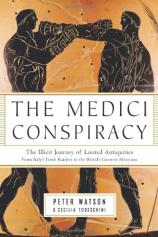The Medici Conspiracy: The Illicit Journey of Looted Antiquities--from Italy's Tomb Raiders to the World's Greatest Museums
Review
The Medici Conspiracy: The Illicit Journey of Looted Antiquities--from Italy's Tomb Raiders to the World's Greatest Museums
Ever wonder where all the vases and statues in museums and
antiquities collections come from? No? Join the club! As Peter
Watson and Cecilia Todeschini demonstrate in meticulous detail, art
dealers, auction houses and museum curators are also less than
obsessed with the question, and their incuriosity has allowed a
flourishing trade in vandalism, grave-robbing and
trafficking.
Watson and Todeschini illustrate this appalling practice through
the case of Giacomo Medici (no known relation to Lorenzo of the
Italian Renaissance), whose systematic pillaging of Greek and
Italian antiquities has devastated the field of archeology and
robbed these countries of their heritage. Let's say an ancient
Greek vase comes on the market. This vase is supposed to have a
provenance, a documented history of legal ownership and an
explanation of how it came to be excavated. Both buyers and sellers
are supposed to ensure that this provenance is accurate. How would
such an item come to lack a provenance? It could be stolen from a
museum or established collection, it could be a fake, or it simply
could have been illegally dug out of the ground, never reported,
and the paperwork manipulated to get it out of the country.
Giacomo Medici used all these tactics and more, with the willing
complicity of collaborators ranging from rustic tomb-robbers
(tombaroli, as they're called) to the swankiest auction houses and
museums all over the world, including Sotheby's, the J. Paul Getty
Museum, and the Metropolitan Museum of Art.
It took the cooperation of police departments all over the world
and an extremely complex investigation lasting over a decade to
stop Giacomo Medici, whose bizarre habit of having himself
photographed in front of his most successful antiquities was a key
element in the case against him. The investigation may have been
complicated but the motives of those involved were pretty simple.
Ambition on the part of museum curators played a part, with
everyone scrapping to get the most prestigious collections, but
mainly this story is about greed.
The irony is that so many players in this story could be so
consumed by greed and so ignorant of value. The tombaroli found a
buried room in Pompeii that had been untouched since Vesuvius
erupted, and they chopped up the wall frescos to transport them
more easily abroad and ruined the rest. A unique, unrepeatable
archeological find, and it's treated like a stolen Dodge in a
chop-shop.
There are no car chases or fiery explosions, but THE MEDICI
CONSPIRACY is a gripping crime story of epic proportions.
Reviewed by Colleen Quinn on January 7, 2011
The Medici Conspiracy: The Illicit Journey of Looted Antiquities--from Italy's Tomb Raiders to the World's Greatest Museums
- Publication Date: April 24, 2006
- Genres: Art, History, Nonfiction
- Hardcover: 408 pages
- Publisher: PublicAffairs
- ISBN-10: 1586484028
- ISBN-13: 9781586484026




